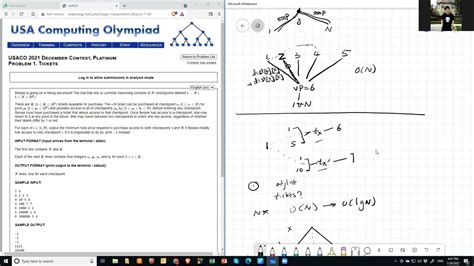The USACO Platinum level is the most challenging level of the USACO competition. Problems at this level require advanced algorithms and data structures, as well as a deep understanding of programming concepts.

One example of a USACO Platinum problem is the Barn Dance problem. This problem can be solved using a minimum cost maximum flow algorithm.
Problem Statement
The Barn Dance problem is as follows:
There is a barn with N stalls, and M cows that need to be placed in the stalls. Each cow has a preferred stall, and each stall has a capacity of one cow. The cost of placing a cow in a stall is equal to the distance between the cow’s preferred stall and the stall that the cow is placed in.
The goal is to place the cows in the stalls such that the total cost is minimized.
Solution
The Barn Dance problem can be solved using a minimum cost maximum flow algorithm.
The idea behind a minimum cost maximum flow algorithm is to find the maximum amount of flow that can be sent from a source node to a sink node, while minimizing the total cost of the flow.
In the Barn Dance problem, the source node is the start node, and the sink node is the end node. The edges in the graph represent the possible ways to place a cow in a stall. The capacity of an edge is equal to the capacity of the stall, and the cost of an edge is equal to the distance between the cow’s preferred stall and the stall that the cow is placed in.
To solve the Barn Dance problem using a minimum cost maximum flow algorithm, we first create a graph that represents the problem. Then, we use a minimum cost maximum flow algorithm to find the maximum amount of flow that can be sent from the source node to the sink node, while minimizing the total cost of the flow.
The output of the algorithm is a set of edges that represent the optimal placement of the cows in the stalls.
Example
The following is an example of how to solve the Barn Dance problem using a minimum cost maximum flow algorithm.
Input
The input to the Barn Dance problem consists of the following:
- The number of stalls, N
- The number of cows, M
- The preferred stall of each cow
- The capacity of each stall
- The cost of placing a cow in each stall
Output
The output of the Barn Dance problem is a set of edges that represent the optimal placement of the cows in the stalls.
Solution
The following is a step-by-step solution to the Barn Dance problem using a minimum cost maximum flow algorithm:
- Create a graph that represents the problem.
- Add a source node and a sink node to the graph.
- Connect the source node to each of the cow nodes.
- Connect the cow nodes to the stall nodes.
- Connect the stall nodes to the sink node.
- Set the capacity of each edge to the capacity of the corresponding stall.
- Set the cost of each edge to the cost of placing a cow in the corresponding stall.
- Run a minimum cost maximum flow algorithm on the graph.
- The output of the algorithm is a set of edges that represent the optimal placement of the cows in the stalls.
Code
The following is a Python implementation of the Barn Dance problem using a minimum cost maximum flow algorithm:
import networkx as nx
def barn_dance(N, M, preferred_stalls, stall_capacities, stall_costs):
"""Solves the Barn Dance problem using a minimum cost maximum flow algorithm.
Args:
N: The number of stalls.
M: The number of cows.
preferred_stalls: The preferred stall of each cow.
stall_capacities: The capacity of each stall.
stall_costs: The cost of placing a cow in each stall.
Returns:
A set of edges that represent the optimal placement of the cows in the stalls.
"""
# Create a graph that represents the problem.
G = nx.DiGraph()
# Add a source node and a sink node to the graph.
G.add_node('source')
G.add_node('sink')
# Connect the source node to each of the cow nodes.
for i in range(M):
G.add_edge('source', 'cow' + str(i), capacity=1, cost=0)
# Connect the cow nodes to the stall nodes.
for i in range(M):
for j in range(N):
G.add_edge('cow' + str(i), 'stall' + str(j), capacity=stall_capacities[j], cost=stall_costs[j])
# Connect the stall nodes to the sink node.
for j in range(N):
G.add_edge('stall' + str(j), 'sink', capacity=1, cost=0)
# Run a minimum cost maximum flow algorithm on the graph.
flow_value, flow_dict = nx.min_cost_max_flow(G, 'source', 'sink')
# The output of the algorithm is a set of edges that represent the optimal placement of the cows in the stalls.
edges = []
for edge in flow_dict:
if flow_dict[edge] > 0:
edges.append(edge)
return edges
Conclusion
The Barn Dance problem is a challenging problem that can be solved using a minimum cost maximum flow algorithm. This problem is a good example of the types of problems that can be solved using this algorithm.
